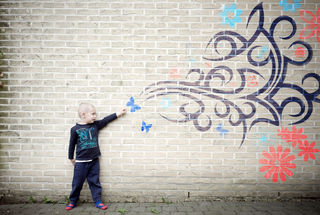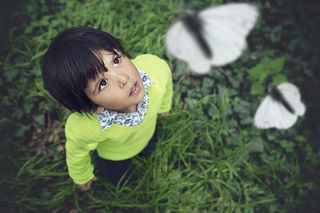The stories we tell ourselves matter. They make a difference in how we think about who we are and the way we structure our lives. They affect the paths we blaze and those we follow. Our stories inform every sigh and every tear, keep us afloat, and connect us to the ones we love.
But so often, these stories that are so fundamental to who we are, are based upon just some of the facts from our complex and beautiful lives. We are our stories, no doubt. But we are so much more too.
I remember the day my parents came and told me I would be held back in the first grade. We had recently moved. My sister had just been born. There were many other distractions for an otherwise distractible young boy.
It was summertime and I wanted to play. I didn’t give the matter any other thought. But when school began again the following year, and all the children went out for recess, I saw my friends on top of the hill. That is where the second graders played. Looking up, I deduced they must be smarter than me.
My parents had handled the matter with elegance and grace. Throughout my life, they could not have given me more love or support. With patience and care they explained why they and the teachers decided I should repeat first grade. I did need an extra year. Not everyone matures in the same way or at the same time. But thereafter, anytime anything was hard – first grade, middle school, when I was still getting “Ds” in senior high – it all made sense. “It was difficult,” I thought, “because I was not as smart as the other kids.”
When I was accepted into the honors program at my college, I thought I had fooled them. My advisor gave a stiff critique of my thesis (as advisors do) and I felt I had finally been “found out”. I dropped out of that program. Then there was law school. Then there was the big firm where only the top students from the top schools would go. Every time anything was difficult, it was all the proof I needed that I did not belong.
But the whole time, there were other truths too. In third grade, Mrs. Kujala selected
 my poem from among all of the those in the class to hang on the wall. Or there was that time Mr. Modispaugh encouraged me to sign up for honors biology. There were other teachers too. There were the things my parents pointed out. These other facts were there the whole time and could have told a different story, that I didn’t hear.
my poem from among all of the those in the class to hang on the wall. Or there was that time Mr. Modispaugh encouraged me to sign up for honors biology. There were other teachers too. There were the things my parents pointed out. These other facts were there the whole time and could have told a different story, that I didn’t hear.I had never heard of growth mindset. I thought “intelligence” was something fixed, not a quality that could be developed or expanded. I never sensed what the philosophers and physicists knew: No matter how many facts we have, there will be many theories that explain them. Our very lives are bundles of hypotheses. At six-years old, I took the evidence collected by me and made a premature cognitive commitment that affected and governed my life for years. I never knew that the fact that things were difficult or hard could mean many things. I only let it feed my self-doubt. Maybe things were difficult for the other kids too? Maybe some things that I found easy, were hard for others. Maybe the key to “intelligence” or “success” or getting along with your teenager is in going to the limits and rough patches of your world and playing within that space; rejoicing when we stumble and noticing all the possible futures it reveals.
How often do we do that in our lives? We hold fast to facts that are absolutely true: Sometimes, joyful; sometimes, tragic. We look at how we have been neglected or abused or taken advantage of, and weave these truths into a story that is somehow less than true. We become nothing but that narrative.

Keep the narratives you’ve written for their limited truths. But learn also to let go. We are always capable of the best futures we can imagine.
(And we have a powerful effect on how others see theirs lives too. Changing the Narrative, Part 2)
©2018 John Albert Doyle, Jr.
References:
“I had never heard of growth mindset” – According to Carol Dweck, a “fixed mindset” is one in which we assume that our character, intelligence, creativity, leadership or other qualities are static and unmalleable. We believe we cannot change them in any meaningful way. Success in the given domain is an affirmation of something fixed and inherent. Challenges or “failures” delineate the limits of our abilities. By contrast, a “growth mindset,” sees our various qualities as pliant and plastic. It leads us to seek out challenges and see “failures” not as evidence of limits, but as real opportunities to stretch and grow. The types of mindset are domain specific. For example, we might have a growth mindset about intelligence, but a fixed mindset about creativity. In most contexts, a growth mindset contributes significantly to our personal and professional success, the health of our relationships and ultimately our capacity for happiness. Dweck, Carol S. Mindset: the new psychology of success. Ballantine Books, 2008.
“I never sensed what the philosophers and physicists knew” – Physicist Pierre Duhem, and philosopher Willard Van Orman Quine both noticed that scientists will explain the same scientific data and other evidence with different theories. According to the Duhem–Quine thesis, even in scientific inquiries, “theories are underdetermined by the evidence.” For more on the Duhem–Quine thesis, see: Stanford, Kyle, “Underdetermination of Scientific Theory“, The Stanford Encyclopedia of Philosophy (Winter 2017 Edition), Edward N. Zalta (ed.),
Image Sources:
Philippe Put/Flickr, “boy wall grafitti” used under a Creative Commons Attribution 2.0 Generic license.
Philippe Put/Flickr, “forest walk” used under a Creative Commons Attribution 2.0 Generic license.






Pingback: Changing the Narrative (Part 2) – Sean Doyle